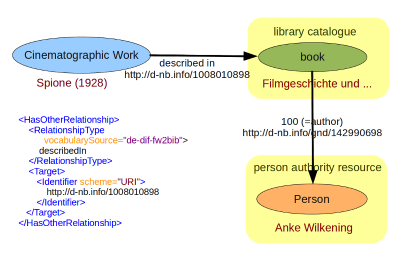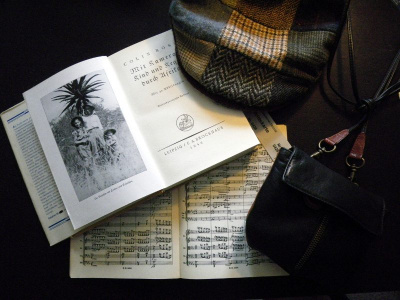Difference between revisions of "In-house usage scenarios"
From filmstandards.org
| (5 intermediate revisions by the same user not shown) | |||
| Line 1: | Line 1: | ||
''From the [[TC 372 Workshop Compendium]]'' | ''From the [[TC 372 Workshop Compendium]]'' | ||
| − | + | It often seems easier for libraries to share their catalogue with other libraries, for museums to share metadata with other museums, etc., than to connect different departments within a single institution. In-house metadata interoperability is still rarely achieved. | |
{| style="float: right; border: 1px solid #BBB; margin: .46em 0 0 .2em;" | {| style="float: right; border: 1px solid #BBB; margin: .46em 0 0 .2em;" | ||
| Line 10: | Line 10: | ||
| valign="top" width="405px" | | | valign="top" width="405px" | | ||
| − | + | Why is it that most cinematheques collect various things in addition to moving images? | |
| − | + | It is because we tend to think of '''cinema''' as something that '''is embedded in a cultural context'''. How can we make our catalogues and other knowledge tools reflect this context? | |
|} | |} | ||
| + | |||
| + | |||
| + | {| style="float: right; border: 1px solid #BBB; margin: .46em 0 0 .2em;" | ||
| + | |- | ||
| + | | valign="top" width="405px" |[[File:Linkfriendly1.png|400px]]<br /> | ||
| + | <span style="font-size:8pt"> | ||
| + | </span> | ||
| + | |||
| + | | valign="top" width="405px" | | ||
| + | In this example, we use a '''link-friendly''' library catalogue. Any catalogue record from the Deutsche Nationalbibliothek (DNB) can be retrieved via a URI that is agreed to remain constant throughout the lifetime of the institution. In this case, it is an HTTP URI that can be invoked directly from any Web browser: [http://d-nb.info/1008010898 http://d-nb.info/1008010898]. | ||
| + | |||
| + | At present, the DNB catalogue is not as link-friendly as it could be. If it were capable of supplying the catalogue record in '''RDF''', then standard software tools could immediately '''explore further paths''', e.g. retrieving the authority record for the author ([http://d-nb.info/gnd/142990698 http://d-nb.info/gnd/142990698]). | ||
| + | |} | ||
| + | |||
| + | {| style="float: right; border: 1px solid #BBB; margin: .46em 0 0 .2em;" | ||
| + | |- | ||
| + | | valign="top" width="405px" |[[File:Reisestecker-b.jpg|400px]]<br /> | ||
| + | <span style="font-size:8pt"> | ||
| + | From http://commons.wikimedia.org/wiki/File:Reisestecker.jpg | ||
| + | </span> | ||
| + | |||
| + | | valign="top" width="405px" | | ||
| + | How can we make a catalogue link-friendly? | ||
| + | |||
| + | '''Define a Uniform Resource Identifier''' (URI) for each unit of information (e.g. catalogue record, or part thereof). Make sure that the URI can remain stable over a long period of time. | ||
| + | |||
| + | '''Let a Web server respond''' to a HTTP URI request with the set of associated metadata (e.g. a catalogue record). Observe the rules of the game and use an agreed data model (i.e. RDF) and offer a choice of recommended encodings (XML, N3/Turtle, and something human-readable). | ||
| + | |||
| + | '''Enrich your metadata''' with relationship statements. Use publicly available vocabularies for relationship types, and URIs for relationship targets. | ||
| + | |||
| + | And that's about all. | ||
| + | |} | ||
| + | |||
| + | {| style="float: right; border: 1px solid #BBB; margin: .46em 0 0 .2em;" | ||
| + | |- | ||
| + | | width="810px" style="background-color:#F0F0F0" | | ||
| + | References and Materials: In-house usage scenarios | ||
| + | * [http://linkeddatabook.com/editions/1.0/ The Linked Data Book. Explains how to publish linked data.] | ||
| + | |||
| + | * [http://www.ala.org/ala/mgrps/divs/lita/ital/282009/2802jun/yee_pdf.cfm Can Bibliographic Data be Put Directly onto the Semantic Web? - Martha M. Yee (2009)] | ||
| + | |} | ||
| + | |||
{| height="20px" width="100%" | {| height="20px" width="100%" | ||
|- style="text-align:center; " | |- style="text-align:center; " | ||
| − | |<span style="color:#808080"> • Previous: [[Relationships with objects in other databases]] • Up: [[TC 372 Workshop Compendium|Contents]] • Next: [[ | + | |<span style="color:#808080"> • Previous: [[Relationships with objects in other databases]] • Up: [[TC 372 Workshop Compendium|Contents]] • Next: [[Filmographic information in the ocean of data]] • </span> |
|- | |- | ||
|} | |} | ||
Latest revision as of 08:34, 22 May 2011
From the TC 372 Workshop Compendium
It often seems easier for libraries to share their catalogue with other libraries, for museums to share metadata with other museums, etc., than to connect different departments within a single institution. In-house metadata interoperability is still rarely achieved.

|
In this example, we use a link-friendly library catalogue. Any catalogue record from the Deutsche Nationalbibliothek (DNB) can be retrieved via a URI that is agreed to remain constant throughout the lifetime of the institution. In this case, it is an HTTP URI that can be invoked directly from any Web browser: http://d-nb.info/1008010898. At present, the DNB catalogue is not as link-friendly as it could be. If it were capable of supplying the catalogue record in RDF, then standard software tools could immediately explore further paths, e.g. retrieving the authority record for the author (http://d-nb.info/gnd/142990698). |
 From http://commons.wikimedia.org/wiki/File:Reisestecker.jpg |
How can we make a catalogue link-friendly? Define a Uniform Resource Identifier (URI) for each unit of information (e.g. catalogue record, or part thereof). Make sure that the URI can remain stable over a long period of time. Let a Web server respond to a HTTP URI request with the set of associated metadata (e.g. a catalogue record). Observe the rules of the game and use an agreed data model (i.e. RDF) and offer a choice of recommended encodings (XML, N3/Turtle, and something human-readable). Enrich your metadata with relationship statements. Use publicly available vocabularies for relationship types, and URIs for relationship targets. And that's about all. |
|
References and Materials: In-house usage scenarios |
| • Previous: Relationships with objects in other databases • Up: Contents • Next: Filmographic information in the ocean of data • |
